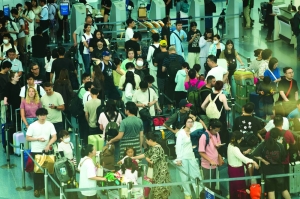Flying remains safest mode of transport albeit safety is uncompromisable


Passengers at Haneda Airport in Tokyo. Despite the recent airline crash in Brazil and many other recorded airline incidents around the world, flying remains the safest mode of transport.
Video shared on social media showed the ATR-72 aircraft, which was bound for Sao Paulo’s international airport from Cascavel, in the state of Parana, spinning out of control as it plunged down behind a cluster of trees near houses, followed by a large plume of black smoke.
Franco-Italian ATR, jointly owned by Airbus and Leonardo, is the dominant producer of regional turborprop planes seating 40-70 people.
Despite the recent airline crash in Brazil and many other recorded airline incidents around the world, flying remains the safest mode of transport.
A recent report by the International Civil Aviation Organisation (ICAO) indicated that 2023 was the safest year in the past five years in terms of safety indicators such as global accident rate, number of fatal accidents, total fatalities and fatality rate.
According to ICAO data, the global passenger traffic continued to increase in 2023 with around 4.2bn passengers transported worldwide, up from 3.2bn passengers in 2022.
Although still slightly below pre-pandemic (2019) levels with 4.5bn passengers having been transported worldwide, passenger traffic in 2023 increased 30% from 2022.
The number of flight departures for scheduled commercial operations continued to increase by approximately 13% with over 35mn departures in 2023, compared to around 31mn in 2022.
Yearly accident statistics indicate a slight increase in the total number of accidents and a decrease in the global accident rate in 2023.
From 2022 to 2023, there was a 3.1% increase in the total number of accidents, as reported by states, noting that the flight departures increased around 13% during the same period of time.
The global accident rate of 1.87 accidents per million departures in 2023 decreased by 17.9% from the 2022 rate of 2.05 accidents per million departures.
In 2023, scheduled commercial air transport accidents resulted in 72 fatalities representing a more than 50 per cent decrease from 160 in 2022, as well as a decrease in fatality rate of 17 people per billion passengers from 50 per billion in 2022.
The number of fatal accidents significantly decreased from seven in 2022, to one in 2023.
Recently, the International Air Transport Association announced that the number of airline CEOs committing to the IATA Safety Leadership Charter has reached 73. This reinforces aviation’s already strong safety culture which contributed to some best-ever results in 2023, including no fatalities among IATA member airlines or the airlines on the IATA Operational Safety Audit Registry.
“Strong leadership and strong safety culture are interdependent. And both are needed to drive continuous improvements in safety performance. By putting their names to the IATA Safety Leadership Charter, 73 airline CEOs have set an example for their airlines and for the industry. In doing so, the Charter is a call to action that keeps in focus the critical obligation of airline CEOs to lead a safety culture that keeps their passengers and staff safe,” noted Willie Walsh, IATA’s Director General.
Walsh noted previously: “2023 safety performance continues to demonstrate that flying is the safest mode of transport. Aviation places its highest priority on safety and that shows in the 2023 performance. Jet operations saw no hull losses or fatalities. 2023 also saw the lowest fatality risk and all accident rate on record. A single fatal turboprop accident with 72 fatalities, however, reminds us that we can never take safety for granted. And two high profile accidents in the first month of 2024 show that, even if flying is among the safest activities a person can do, there is always room to improve. This is what we have done throughout our history. And we will continue to make flying ever safer.” Undoubtedly, the air transport industry plays a significant role in global economic activity and development. One of the key elements to maintaining the vitality of civil aviation is to ensure safe, secure, efficient and environmentally sustainable operations at the regional, national and global levels.
n Pratap John is Business Editor at Gulf Times. X handle: @PratapJohn



